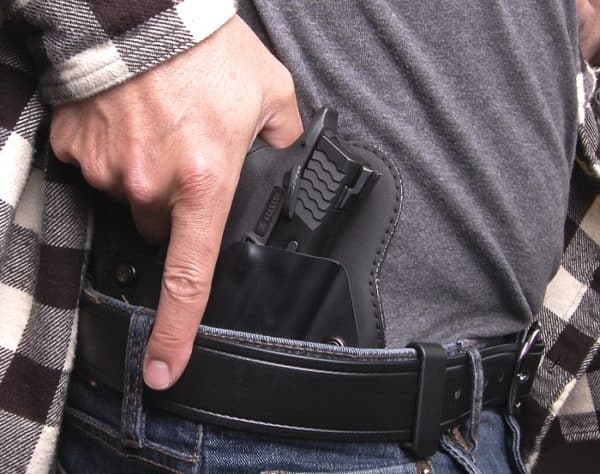Owning a weapon can be a lot of fun, but it also requires that you follow some basic safety measures. One of the first things you’ll need to master is how to draw a gun from a holster so that, in an emergency, you don’t injure yourself or any innocent people around you.

BASICS OF DRAWING FROM A HOLSTER
When you want to draw your weapon, keep your arm close to your body and grip the handle of your gun. In one fluid motion, release the holster retention and draw your gun straight out. Keep your finger off the trigger. Pivot your arm to bring it to the front of your body and point your barrel toward your target. With your arms extended, put your finger on the trigger and fire.
SAFETY
Safety should be the first priority of a responsible gun owner. Always practice your draw with an unloaded weapon. Eject the clip and do a visual inspection of the chamber to make sure that it’s empty. Accidental discharges can happen to people who practice a skill while their gun is loaded. Don’t be that person.
Prioritizing trigger safety is essential to developing the proper drawing technique. When your hand is on your holstered gun, keep your finger off the trigger. When you pull the gun out of the holster, keep your finger off the trigger. When you swing your arm upward and aim your gun, keep your finger off the trigger.
Your finger should stay positioned along the barrel of the gun until you’re ready to fire. If you’re not prepared to face the consequences of sending a bullet flying out of your gun’s chamber, keep your finger off the trigger.
It probably goes without saying, but always practice drawing your gun from where you’re going to actually carry it. You’re wasting your time if you practice drawing from your hip but end up carrying at your kidney. All of your practice factors should be identical to how they’ll be in real life, except that you’ll keep your gun unloaded during practice.
DETAILED DRAWING TIPS
We’re going to break down the full process of drawing a weapon from a holster on your strongside so that you can master each step.
MOVE YOUR CLOTHING
The first step to drawing is to sweep away any clothing that’s covering your weapon. Most people use their non-dominant hand for this. While your dominant hand is moving toward your gun, your non-dominant one should be clearing the way.
REACH FOR YOUR GUN
Reach for your gun with your dominant hand. The web between your thumb and forefinger should rest on the backstop of your gun (the curved indentation below the slide, at the top of the grip). Check out this video to see where your hand should land:
RELEASE THE RETENTION AND BEGIN PULLING OUT YOUR GUN
Holsters come with many different styles of retention like straps or buttons. They may also have passive retention (when the fit of the holster is so snug that it holds the weapon securely). Whatever style you have, practice releasing the retention smoothly and efficiently. Keep practicing until you can release the retention without looking down at your holster.
This video is an overview of the entire draw, but pay special attention to how fluidly the instructor releases his retention and gets his gun out of the holster. Also, note that he keeps his trigger finger positioned along the barrel throughout his draw.:
BRING YOUR ARM STRAIGHT UP, THEN DROP YOUR ELBOW
Once you’ve released the retention, draw your weapon straight out of the holster. Keep your trigger finger on the barrel of your gun. Your elbow should be pointing toward the sky throughout this portion. If your elbow drops behind you too soon, your gun may become wedged in the holster and be more challenging to draw.
Once your weapon is entirely out of the holster, drop your elbow so that it points behind you.
BRING YOUR NON-DOMINANT HAND TO YOUR GUN, STRAIGHTEN YOUR ARMS, AND AIM
Keeping your elbow tucked into your body, bring your non-dominant hand toward your gun. At the same time, begin extending your arms out in front of you. You should eventually be able to do this in a quick, smooth motion. Your finger should still be off your trigger throughout this movement.
Check out this detailed video to see precisely how your arms should move throughout your draw.
PUT YOUR FINGER ON THE TRIGGER AND FIRE
At last, it’s safe to put your finger on the trigger because you’re ready for your bullet to fly. After you’ve fired your weapon, take your finger off the trigger and bring the gun back toward your body.
REHOLSTERING YOUR WEAPON
There’s no rush on this step because the emergency is over, so SLOWLY raise your elbow to the sky as you move your arm backward and put your gun into your holster. If you have a button retention, you should hear a click once your weapon is secure. If you have a strap, put it over the gun and clip it in place.
TAKE YOUR PRACTICE TO THE NEXT LEVEL
Once you’ve mastered the basic draw, try the following variations so you’ll be prepared to draw in any situation:
- Practice drawing while wearing a jacket, with your shirt tucked in, with your shirt untucked and covering your weapon, in jeans, in dress pants, and in any other type of clothing you may wear.
- Practice drawing, firing the empty weapon, releasing the empty magazine, and reloading a new one.
- Practice drawing while seated. Drawing from standing is much easier, but you can’t always stand to draw. If you’re sitting in a restaurant, the last thing you want to do is stand and draw an assailant’s attention to your while you’re trying to access your weapon.
CONCLUSION
Knowing how to draw a gun from a holster is an essential aspect of responsible gun ownership. Practice over and over until you can reach your weapon, release the retention, pull the gun out of the holster, and aim it fluidly without having to think about every step. In an emergency, you want your muscle memory to be so solid that your nerves don’t even have time to take over.
If you enjoyed this article you’ll probably like these:


